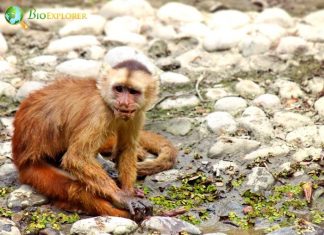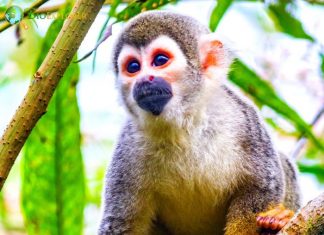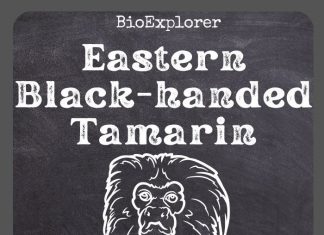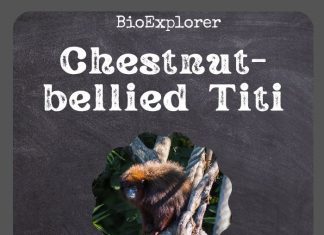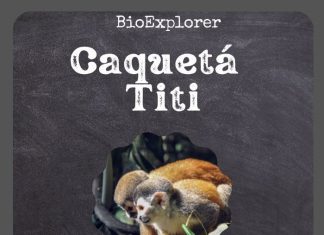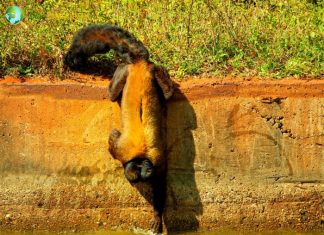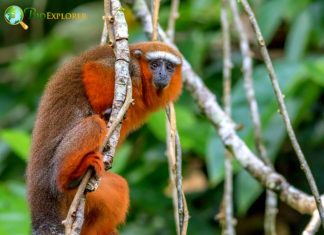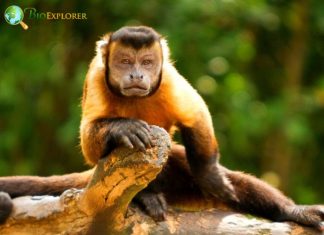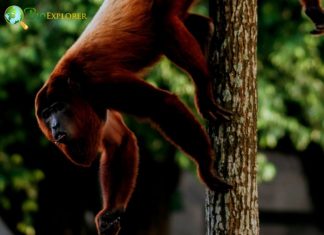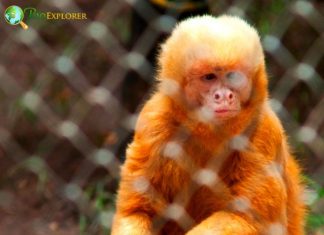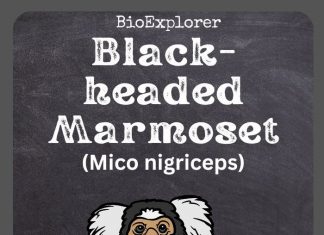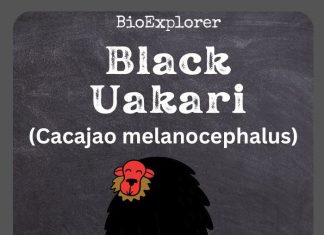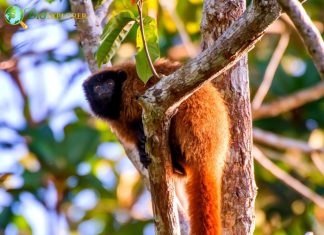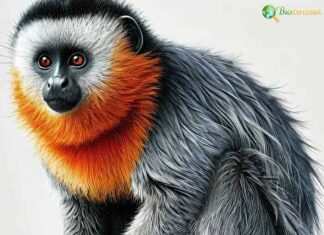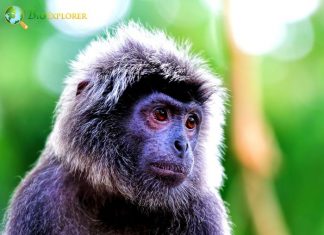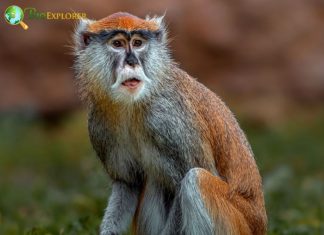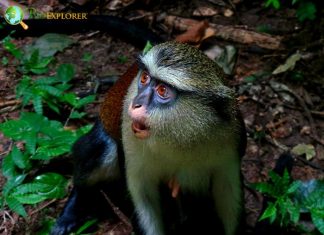Golden Angwantibo
Species Name: Arctocebus aureus
The golden angwantibo is a strepsirrhine primate of the Lorisidae family. Bärenmaki, meaning "lemur bear," is the German name for the golden angwantibo due to its bear-like appearance. However, we see no resemblance.
Gold-And-White Marmoset
Species Name: Mico chrysoleucos
The gold-and-white marmoset, also called the golden-white tassel-ear marmoset, is a species of marmoset, a tiny monkey native to the Amazon rainforest in the eastern Amazonas state of Brazil.
Equatorial Saki
Species Name: Pithecia aequatorialis
The Equatorial Saki, also known as the red-bearded Saki, is a species of saki monkey and New World monkey. They are most common in riparian, seasonally flooded, and swampy forests but have also been seen in terra firme forests.
Ecuadorian Capuchin
Species Name: Cebus aequatorialis
The Ecuadorian capuchin, also known as the Ecuadorian white-fronted capuchin, is a species of a graceful capuchin monkey in the Cebidae family. The highest-ranking female dominates all group members except the highest-ranking male.
Ecuadorian Squirrel Monkey
Species Name: Saimiri macrodon
The Ecuadorian squirrel monkey is a species of the squirrel monkey. Although it occasionally ventures to the ground to play or feed, the Ecuadorian squirrel monkey is strictly an arboreal primate.
Eastern Black-handed Tamarin
Species Name: Saguinus ursula
The Eastern black-handed marmoset (Saguinus ursulus) is a species of marmoset native to Brazil. These tamarins are mainly covered in jet-black fur, with only a small area around the nose and eyes and most hairless ears.
Collins’ Squirrel Monkey
Species Name: Saimiri collinsi
Collins' Squirrel Monkey is a species of squirrel monkey endemic to Brazil. Until a genetic study by Jessica Lynch Alfaro et al. raised them to the species category, Collins' squirrel monkey had been considered a subspecies of the squirrel monkey (Saimiri sciureus).
Collared Titi
Species Name: Cheracebus torquatus
The collared titi, also called the widow monkey, or yellow-handed monkey inhabits the lush rainforests of the Amazon and is typically found south of Río Negro and north of Río Solimões. Titi monkeys are often known to "duet" with each other, either between an adult female and an adult male, an adult female and her son, or an adult male and his daughter.
Coimbra Filho’s Titi
Species Name: Callicebus coimbrai
or Coimbra titi is a species of titi, a New World primate native to the forests of the Brazilian states of Sergipe and Bahia. It is named in honor of Adelmar F. Coimbra-Filho, founder and former director of the Rio de Janeiro Primate Center, for his Brazilian biology and primatology work.
Coastal Black-handed Titi
Species Name: Callicebus melanochir
The coastal black-handed titi is another species of titi, a New World primate native to the Atlantic Forest of northeastern Brazil. Coastal black-handed Titi monkeys vocalize synchronously early in the morning, possibly to announce their presence in their territory.
Chestnut-bellied Titi
Species Name: Plecturocebus caligatus
The chestnut-bellied titi monkey is a New World primate species native to Brazil. The Chestnut-bellied Titi monkeys live in family groups consisting of father, mother, and baby monkeys ranging in size from three to seven with other affiliates.
Chacoan Titi Monkey
Species Name: Plecturocebus pallescens
The Chacoan Titi Monkey is a species of titi (also called White-coated Titi), a type of New World monkey native to South America. These diurnal monkeys are stealthy and hard to spot as they navigate the canopy. They move between branches and trees by walking or jumping on four limbs.
Cazuza’s Saki
Species Name: Pithecia cazuzai
Cazuza's Saki is native to northwestern Brazil. Populations of this species were previously classified as Rio Tapajós saki (Pithecia irrorata). Still, a 2014 study found that these populations had a pelage distinct from all other species in the genus and were therefore considered their own species, Pithecia cazuzai.
Caquetá Titi
Species Name: Plecturocebus caquetensis
The caquetá titi also called the bushy-bearded titi or red-bearded titi, is a species of titi monkey native to Colombia in the Caquetá region. Dr. Marta Bueno, Thomas Defler, and their student Javier García of the National University of Colombia are credited with the 2008 discovery of the Caquetá-Titi monkey.
Burnished Saki
Species Name: Pithecia inusta
The Burnished saki is a species of saki monkey, a species of New World monkey. It is located in central Peru and a small part of adjacent Brazil. The species was described by Johann Baptist von Spix in 1823 but was later merged with the monk saki (Pythecia monachus).
Buffy-headed Marmoset
Species Name: Callithrix flaviceps
The buffy-headed marmoset is a rare species of marmoset native to the tropical rainforests of southeastern Brazil. These miniature and shy monkeys are mostly tree dwellers, crawling on 4 legs (quadrupeds) from tree to tree with jerky, squirrel-like movements.
White-footed Saki
Species Name: Pithecia albicans
The white-footed Saki, also called the white Saki or buff saki, is a species of saki monkey, a New World species native to western Brazil. They hang from branches and hold on with their hind legs while eating seeds and fruits.
Brumback’s Night Monkey
Species Name: Aotus brumbacki
Brumback's Night Monkey is a nocturnal monkey species found in Colombia. Still, recently, it has been argued that it should be considered a separate species. The species is named in honor of the American naturalist and physician Roger Brumback.
Brown-backed Bearded Saki
Species Name: Chiropotes israelita
The brown-backed bearded Saki is one of 5 species of bearded Saki, a New World monkey species. Bearded sakis have a unique appearance. They are born with prehensile tails, which they retain for the first two months of their life. This allows them to cling to their mother's body. After this time, the tail becomes non-prehensile.
Brown Titi
Species Name: Plecturocebus brunneus
The brown titi is another species of titi, a New World monkey native to South America. It was initially described in 1842 as Callicebus brunneus and transferred to the new genus Plecturocebus in 2016.
Brown Weeper Capuchin
Species Name: Cebus brunneus
The brown weeper capuchin, or Venezuelan brown capuchin, is a species of graceful capuchin monkey native to Venezuela. Unlike spider monkeys, brown weeper capuchin monkeys can't hang by their tails because they cannot support their body weight.
Bolivian Red Howler
Species Name: Alouatta sara
The Bolivian red howler monkey is a New-World monkey species native to neotropical South America. The Bolivian red howlers live in groups of 1 to 3 males and 2 to 7 females. Males in bachelor groups try to dominate the female group by wrestling the lead male.
Blond Capuchin
Species Name: Sapajus flavius
The blond capuchin monkey is one of the capuchin monkeys native to northeastern Brazil. These Blonde monkeys get their name from the distinctive golden-blond fur on their bodies. Like other primate species, the blond capuchin is threatened by poaching and trapping for the illegal pet trade.
Black-headed Night Monkey
Species Name: Aotus nigriceps
The black-headed night monkey is a nocturnal monkey species native to South America. The monkeys are small primates about the size of a small squirrel. The black-headed night monkeys in Peru have mainly inhabited degraded areas.
Black-headed Marmoset
Species Name: Mico nigriceps
The black-headed marmoset is a species of marmoset native to Brazil. It inhabits tropical rainforests, mainly second growth and fringes. Black-headed marmoset lives in large family groups of 4 to 15 individuals. Typically, only one female per group breeds during any given breeding season.
Colombian Black-handed Titi
Species Name: Cheracebus medemi
The Colombian Black-handed titi is a species of titi, a New World primate native to Colombia. The Colombian black-handed titi is a diurnal and arboreal monkey that prefers to live in dense forests near water.
Black-fronted Titi
Species Name: Callicebus nigrifrons
The black-fronted titi is a New-World monkey native to Brazil. Black-fronted titi monkeys have short faces, fluffy bodies, long legs, and long fluffy tails. The black-fronted titi monkey is listed as Near Threatened by the IUCN due to extensive habitat loss and fragmentation in the remnant Atlantic Forest in southeastern Brazil.
Roosmalens’ Dwarf Marmoset
Species Name: Mico humilis
The Roosmalens dwarf marmoset, also called the black-crowned pygmy marmoset or black-crowned dwarf marmoset, is a New-World monkey endemic to the Amazon rainforest.
Black Uakari
Species Name: Cacajao melanocephalus
Also called the golden-backed black uakari, golden-backed uakari, and Homboldt's black-headed uakari, the black uakari, is a species native to southwestern Venezuela, southeastern Colombia, and northwestern Brazil. The face of Cacajao melanocephalus is black and bare, hence the common name "black uakari" or "black-faced uakari". The hands and lower limbs are black too.
Barbara Brown’s Titi
Species Name: Callicebus barbarabrownae
Barbara Brown's titi also known as the northern Bahian blond titi or blond titi monkey, is a New World monkey species. Barbara Brown's titi is named in honor of Barbara Elaine Russell Brown, a zoologist.
Atlantic Titi
Species Name: Callicebus personatus
The Atlantic titi, also known as the masked titi, inhabits the rainforests of the Atlantic coast of Brazil east of the Andes in the states of Bahia, Espírito Santo, northwest of Minas Gerais, north of Rio de Janeiro, and São Paulo. This species, found nowhere else in the world, inhabit the tropical forests of Brazil's Atlantic coast east of the Andes.
Ashy Black Titi
Species Name: Plecturocebus cinerascens
The Ashy black titi is a species initially described in 1823 as Callicebus cinerascens. Ashy black titi monkeys live in small families comprising a monogamous pair and their young. Adult males tend to carry their infants unless the mother is nursing.
Alta Floresta Titi
Species Name: Plecturocebus grovesi
The Alta Floresta titi is a distinct but unnamed form of titi (Plecturocebus) rediscovered in 2019 in Chapada dos Parecis, a plateau in the far south of the Brazilian state of Rondônia. This species lives exclusively between the Teles-Pires and Juruena rivers in Mato Grosso.
Sun-Tailed Monkey
Species Name: Allochrocebus solatus
The sun-tailed monkey (Allocrocebus solatus) is among the most understudied primates in its habitat. Discovered as a new species in 1988, it is classified as a guenon, a member of the Cercopithecus genus, but later moved to the Allochrocebus genus.
Red-bellied Monkey
Species Name: Cercopithecus erythrogaster
The red-bellied monkey (Cercopithecus erythrogaster), also called the red-bellied guenon or white-throated guenon is a diurnal primate living in the trees of tropical rainforests or tropical areas in Benin and Nigeria. The red-bellied monkey was once considered extinct due to constant hunting for fur on its unique red belly and white front legs.
Myanmar Snub-nosed Monkey
Species Name: Rhinopithecus strykeri
The Myanmar snub-nosed monkey or black snub-nosed monkey (Rhinopithecus strykeri) is an endangered Colobino monkey species discovered in northern Burma (Myanmar) in 2010. These Asian primates' tails are relatively long, usually around 1.4 times their body length.
Javan Surili
Species Name: Presbytis comata
The grizzled surili (Presbytis comata) is a threatened species of Old World monkey native to the western half of Java, Indonesia, a biodiversity hotspot. The grizzled surili engages in 3 to 4 foraging and feeding fights throughout the day.
Greater Spot-Nosed Monkey
Species Name: Cercopithecus nictitans
The greater spot-nosed monkey (Cercopithecus nictitans), also called the greater white-nosed monkey, putty-nosed monkey, and white-nosed guenons, is among the smallest Old-World monkeys. Great spot-nosed monkeys have a polygamous mating system in which a resident adult male coexists with multiple adult females and their young.
Hose’s Langur
Species Name: Presbytis hosei
The Hose's langur (Presbytis hosei) is a primate species in the Cercopithecidae family native to the island of Borneo, which includes Brunei, Kalimantan (Indonesia), and eastern Malaysia. The species was first identified in 1985 in Sangkulirang Peninsula and Kutai National Park in East Kalimantan, Indonesia.
Dryas Monkey
Species Name: Chlorocebus dryas
The Dryas monkey, also called the Salonga monkey, Inoko, or Ekele is a little-known Old World primate only found in the Congo Basin and restricted to the Congo River's left bank. Unlike guenon monkeys, which make loud leaps and resounding calls, dryas monkeys move silently.
Red-eared Guenon
Species Name: Cercopithecus erythrotis
The red-eared guenon (Cercopithecus erythrotis), also called the russet-eared guenon or red-eared monkey is endemic to the tropical and subtropical lowland rainforests of Nigeria, Equatorial Guinea, and Cameroon.
Tantalus Monkey
Species Name: Chlorocebus tantalus
The tantalus monkey (Chlorocebus tantalus) is an Old World monkey endemic to Africa, ranging from Ghana to Sudan. It was initially described as a subspecies of Grivet (Chlorocebus aethiops). Tantalus monkeys are very similar to vervet monkeys but are smaller in size.
Lang’s Red Colobus
Species Name: Piliocolobus langi
Lang's red colobus (Piliocolobus langi) is another species of red colobus monkey. Historically, it was treated as a subspecies of the Central African red colobus (Piliocolobus foai). Still, more recent taxonomies generally treat it as a distinct species.
Saban Grizzled Langur
Species Name: Presbytis sabana
Saban Grizzled Langur was once thought to be a subspecies of the Hose's langur, Presbytis hosei (as Presbytis hosei sabana). The Saban grizzled langur is endemic to the island of Borneo in the Malaysian province of Sabah, with part of its range in Indonesia.
Pig-tailed Langur
Species Name: Simias concolor
The pig-tailed langur (Simias concolor), monotypic in the Simias genus, is a great Old-World monkey native to several small islands off Sumatra, Indonesia. Adult pig-tailed langurs have black faces and small, turned-up noses.
Mitered Langur
Species Name: Presbytis mitrata
The mitered langur has brown or gray fur on its back, darker, while it is even darker on its belly and the arms, legs, and tail. These Indonesian primates live in groups of 1 male with 5 to 17 females.
Miller’s Langur
Species Name: Presbytis canicrus
Miller's Langur (Presbytis canicrus), also called the Kutai Gray Langur, is the rarest of the four Hosei subspecies, all of which are native to the island of Borneo. One of the world's most endangered primates, Miller's langur, was once considered extinct until it was rediscovered in 2013.
Mentawai Langur
Species Name: Presbytis potenziani
Mentawai Langur is also called the Long-Tailed Langur, and it is native to the Mentawai Islands in Indonesia. The pelage of Mentawai langur is medium length, longer on the back of the shoulders and anterior of the flanks and shorter on the face, neck, abdomen, and under the thighs.
Laotian Langur
Species Name: Trachypithecus laotum
The Laotian langur (Trachypithecus laotum), also known as white-browed black langur, is another primate species that nest in small limestone caves and holes that shelter from predators, rain, and cold.
Hatinh Langur
Species Name: Trachypithecus hatinhensis
The Hatinh langur (Trachypithecus hatinhensis) is a critically endangered Old World monkey found in the limestone forests of Vietnam, particularly in Quảng Bình province. Contrary to their common name, the Hatinh langur is not known from the province of Hà Tĩnh.





